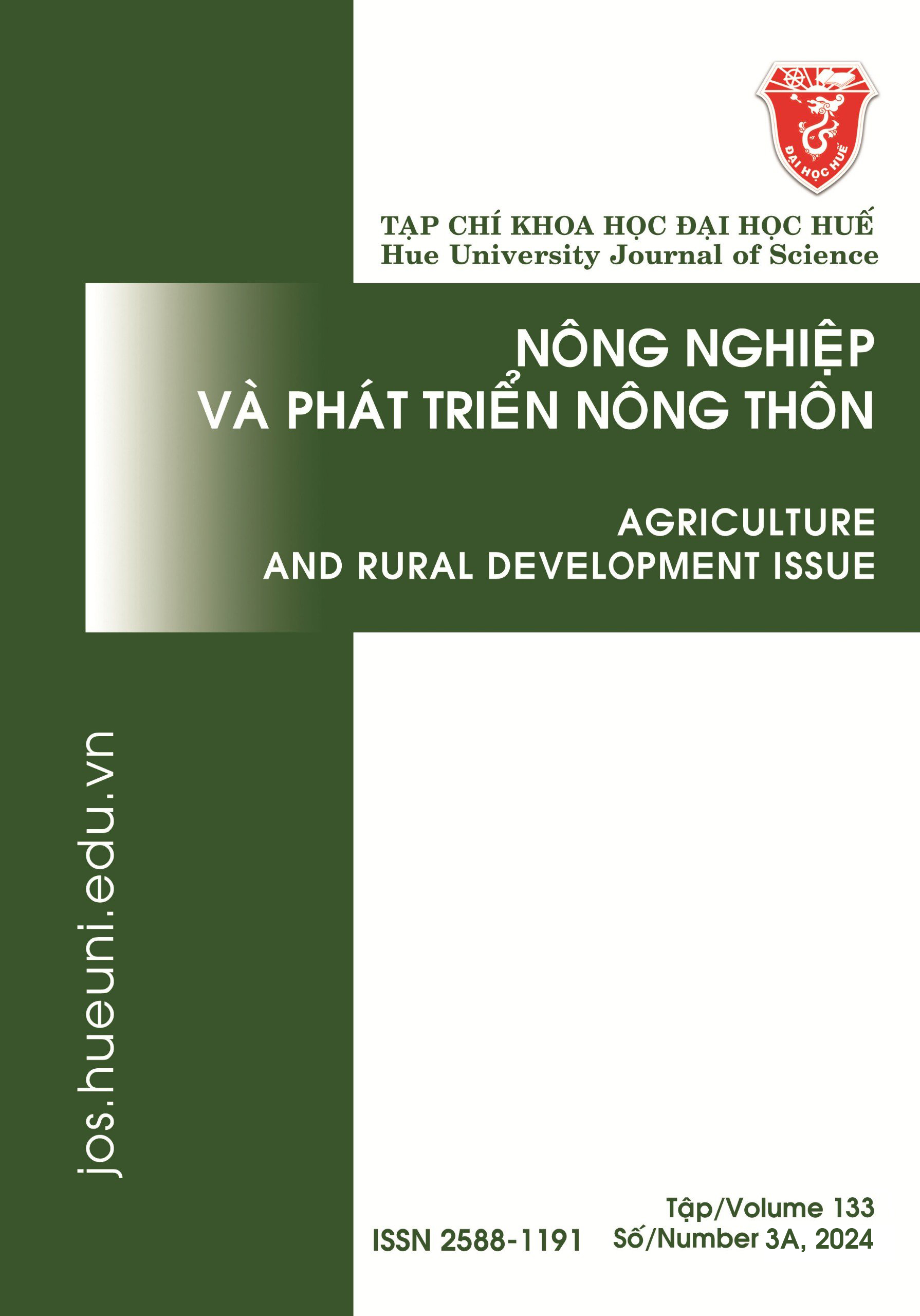Abstract
This study aimed to evaluate the effect of different diets on the growth performance and egg-carrying ratio of rotifer. The experiment was designed as completely randomly designed, including three diets with 3 replications: NT1 (100% Nannochloropsis oculata); NT2 (50% baker’s yeast + 50% Nannochloropsis oculata); and NT3 (100% Selco S.parkle). The results showed that water quality parameters were within the suitable ranges for growing rotifer. After 8 cultured days, the highest density of rotifer was in NT3 (276 ind/mL) and was significantly different from other treatments (p < 0,05). Similarly, the highest population growth rate of rotifer was in NT3 (0.25%) on the sixth day. Also, the highest percentage of egg-carrying rotifer was also in NT3 (32.93%) and was significantly different from other treatments (p < 0,05). The results recommend that Selco S.parkle should be used to enhance the growth performance and biomass of rotifer.
References
- Lubzens, E., Tandler, A., & Minkoff, G. (1989), Rotifers as food in aquaculture, Hydrobiologia, 1(186), 387–400.
- Phạm Thị Tuyết Ngân và Trần Sương Ngọc (2013), Ảnh hưởng của vi khuẩn Bacillus chọn lọc lên luân trùng nước lợ Brachionus plicatilis, Tạp chí khoa học Trường Đại học Cần Thơ, 27, 145–153.
- Duy, V. B. Le, Phuoc, N. N., Kristof, D., Dung, V. N., Peter, D. S., Atsushi, H., Peter, B. (2017), Growth performance of the very small rotifer Proales similis is more dependent on proliferating bacterial community than the bigger rotifer Brachionus rotundiformis, Aquaculture, 476, 185–193.
- Conceição, L. E., Yúfera, M., Makridis, P., Morais, S., Dinis, M. T. (2010), Live feeds for early stages of fish rearing, Aquac Research, 41, 613–640.
- Hawkyard, M., Stuart, K., Langdon, C., Drawbridge, M. (2016), The enrichment of rotifer (Brachionus plicatilis) and Artemia franciscana with taurine liposomes and their subsequent effects on the larval development of California yellowtail (Seriola lalandi), Aquaculture Nutrition, 22, 911–922.
- Watanabe, T., Kitajima, C., & Fujita, S. (1983), Nutritional values of live organisms used in Japan for mass propagation of fish, Aquaculture, 34, 115–143.
- Jamali, H., Imani, A., Abdollahi, D., Roozbehfar, R., and Isari, A. (2015), Use of Probiotic Bacillus spp. in rotifer (Brachionus plicatilis) and Artemia (Artemia urmiana) Enrichment: Effects on Growth and Survival of Pacific White Shrimp, Litopenaeus vannamei, Larvae, Probiotics and Antimicrobial Proteins, 7, 118–125.
- Lubzens, E. (1987), Raising rotifers for use in aquaculture, Hydrobiologia, 147, 245–255.
- Hirata, H., Murata, O., Yamada, S., Ishitami, H., Wachi, M. (1998), Probiotic culture of the rotifer Brachionus plicatili, Hydrobiologia, 387/388, 495–498.
- Trần Sương Ngọc (2017), Giáo trình kỹ thuật nuôi thức ăn tự nhiên, Trường Đại Học Cần Thơ.
- Trần Sương Ngọc, Nguyễn Thành Đức, Nguyễn Tấn Khương, và Vũ Ngọc Út (2010), Ảnh hưởng của tảo Chlorella và men bánh mì lên sự phát triển của quần thể luân trùng nước ngọt (Brachionus angularis) nuôi trên bể, Tạp chí khoa học Trường Đại học Cần Thơ, 4b, 66–75.
- Huỳnh Thanh Tới, Huỳnh Thị Ngọc Hiền, Vũ Hùng Hải, Âu Văn Hóa, Trần Trung Giang và Nguyễn Thị Hồng Vân (2021), Ảnh hưởng thay thế tảo chlorella sp. bằng men bánh mì Saccharomyces cerevisiae lên tăng trưởng quần thể luân trùng Brachionus calyciflorus, Tạp chí Trường Đại học Cần Thơ, 57(2B), 142–150.
- Sorgeloos, P. and Lavens, P. (1996), Manual on the production and use of live food for aquaculture. Fisheries Technical Paper, Food and agriculture organization of the United Nation, Rome, 361, 9–100.
- Nguyễn Thị Kim Liên, Trần Tấn Huy và Nguyễn Thanh Phương (2008), Nuôi luân trùng siêu nhỏ (Brachionus rotundiformis) bằng tảo chlorella và men bánh mì, Tạp chí khoa học trường Đại học Cần Thơ, (1), 67–74.
- Ortega Salas, A. A., Reyes, I. C. and Bustamante, H. R. (2013), Population growth and Cyst production of the rotifer Brachionus plicatilis fed with 3 different diets, Cuad. De invest, 5, 195–199.
- Trần Công Bình, Dương Thị Hoàng Oanh, Quách Thế Vinh, Trần Thị Kiều Trang và Trương Trọng Nghĩa (2006), Nuôi luân trùng (Brachionus plicatilis) thâm canh trong hệ thống tuần hoàn kết hợp với bể nước xanh, Tạp chí khoa học Trường Đại học Cần Thơ, 2006, 102–112.
- Fulks, W. and Main, K. (1991), The design and operation of commercial-scale live feeds production system. In: Fulks, W., Main, K. (eds), rotifer and microalgae culture system, In Proceeding of a US-Asia workshop, The Oceanic institute, HI, 25–52.
- Hoff, H. and Snell, T. W. (1987), Plankton culture manual, The first edition, Florida aqua farm. Florida, USA.
- Fukusho, K. (1989), Biology and mass culture production of the rotifer Brachionus plicatilis, Int. J. aquat. Fish. Technol, 1, 232–240.
- Han, C., Kim, H., Sakakura, Y., and Hagiwara, A. (2022), Species – specific ammonia tolerance in the marine rotifers Brachionus plicatilis and Brachionus rotundiformis: Reproductive characteristics and its mechanisms, Aquaculture, 550(115), 117.
- Planas, M., & Estévez, A. (1989), Effects of diet on population development of the rotifer Brachionus plicatilis in culture, Helgoländer Meeresuntersuchungen, 43, 171–181.
- Tamaru, C. S., Murashige, R., Lee, C. S., Ako, H., Sato, V. (1993), Rotifers fed various diets of baker’s yeast and/or Nannochloropsis oculata and their effect on the growth and survival of striped mullet (Mugil cephalus) and milkfish (Chanos chanos) larvae, Aquaculture, 110, 361–372.
- Kamil Mert Eryalçın (2019), Nutritional value and production performance of the rotifer Brachionus plicatilis Müller, 1786 cultured with different feeds at commercial scale, Aquaculture International, 27, 1–4.
- Hirayama, K., Fish, K. (1973), Fundamental studies on physiology of rotifer for its mass culture IV, Nutritional effect of yeast on population growth of rotifer, Vliz.be, 11, 1129–1133.
